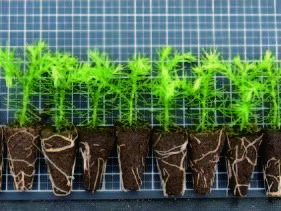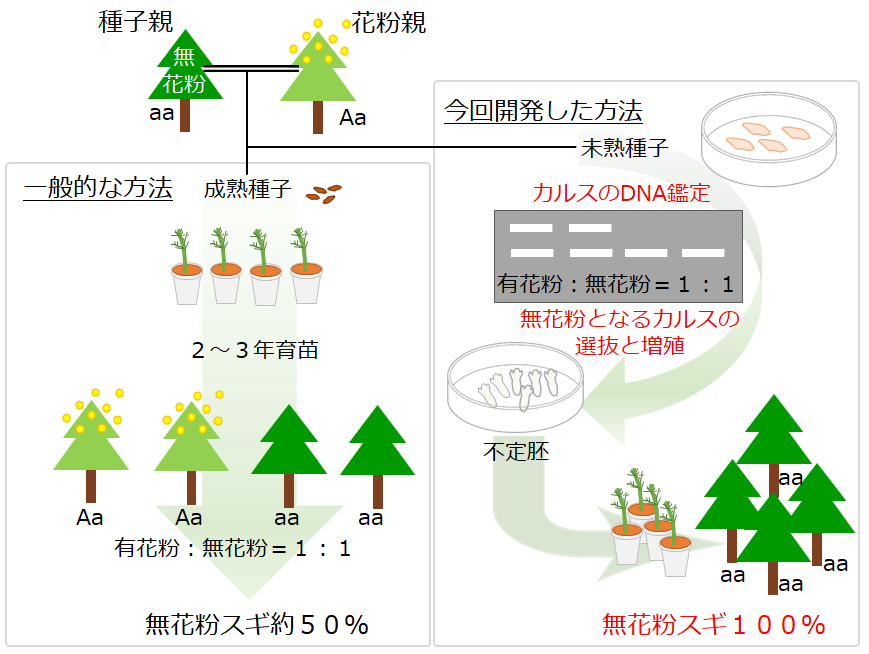(This is an English translation of the original Japanese article.
The publication date refers to that of the Japanese version,
which differs from the upload date of the English version.)
Japanese cedar is widely distributed from Honshu Island to Yakushima in Kyushu. The species accounts for 44% (4.44 million ha) of the area of artificial forests and 18% of the Japanese forest area (data source: Forestry Agency "Current Status of Forest Resources (as of March 31, 2017)"). Because pollen from Japanese cedar is a cause of hay fever, efforts are being made to increase the number of artificial forests of the trees that does not produce pollen. To accomplish this, a large number of male-sterile (pollen-free) seedlings are needed, so a research group led by Niigata University has established tissue culture technology that can mass-produce male-sterile Japanese cedar seedlings. Currently, seedlings produced by this technology are being experimentally planted in national forests in Niigata Prefecture and other places, and surveys have begun to record their growth.
Focusing on male-sterility genes of Japanese cedar
Generally, the male-sterile seedlings are produced from artificial crossing between male-sterile Japanese cedar as seed parents (which have two alleles that make them male-sterility, i.e. homozygous) and Japanese cedar with only one allele that makes them male-sterility (i.e. heterozygous) as pollen parents. After that, the seeds produced by artificial crossing are sown and grown for 2-3 years, then plant hormones are sprayed on the seedlings to force them to flower, and only those without pollen are selected. However, this method requires a long period of 2-3 years to select male-sterile seedlings, and about half of the grown seedlings will produce pollen and can not make shipment as male-sterile seedlings (because the pollen produced by the pollen parent is half with and half without the male-sterile allele).
Therefore, a research group led by Niigata University focused on the male-sterility gene (MS1) that makes male-sterile Japanese cedar and developed a method to identify the male-sterility allele quickly. As a result, examining DNA made it possible to determine whether they have the male-sterility allele or not without forcing flowering.
This research achievement has been compiled by the Forestry and Forest Products Research Institute of the Forest Research and Management Organization (hereinafter referred to as Forestry and Forest Products Research Institute) as "A manual to genotype male sterility gene (MS1) mutations in Cryptomeria japonica D. Don" and is available on their website.
Mass production of male-sterile seedlings by tissue culture
This time, the research group has developed a method to produce male-sterile Japanese cedar seedlings by selecting callus (see Glossary for detail) with two alleles that make them male-sterility by examining immature seed-derived callus using the above method and using tissue culture technology. As a result, it became possible to reduce the period until the selection of male-sterile seedlings in a few months and to mass-produce only those seedlings by tissue culture (Photo 1, Figure 1).
Since 100% of the seedlings grown by this tissue culture will be pollen-free, there is no need to check for the presence or absence of pollen.
The research achievement has been compiled as "Manual for the propagation of pollen-free sugi (Cryptomeria japonica) via somatic embryogenesis" and is available on the website of the Forestry and Forest Products Research Institute.
However, there are still unknown points, such as how seedlings produced by tissue culture will continue growing after planting.Therefore, the research group is accumulating growth data.
 |
 |
| Photo 1 : Male-sterile Japanese cedar seedlings (provided by Verde Co., Ltd.) | Fig. 1 : General method for producing male-sterile Japanese cedar seedlings (left) and newly developed method (right) (provided by the Forestry and Forest Products Research Institute) |
Developing new superior male-sterile Japanese cedar trees in the future
It is said that male-sterile Japanese cedars exist in nature at a rate of one in several thousand. Until now, trees suitable for forestry have been developed using limited trees such as those discovered about 30 years ago. The technology obtained in this study can also be used to select trees that can be used as pollen parents for seed production from breeding materials (those that have only one allele that becomes male-sterility and can produce male-sterile offspring with a probability of 1/2 when crossed with male-sterile Japanese cedars). It is expected to make the development of new male-sterile trees suitable for forestry more efficient.
Associate Professor Moriguchi of the Faculty of Agriculture at Niigata University, the representative institution of the research group, said, "The number of people suffering from Japanese cedar pollen allergies is increasing year by year. The results of this study will greatly contribute to the development and popularization of new superior male-sterile trees. We want to continue our energetic research towards the expansion of male-sterile Japanese cedars."
[Glossary]
Callus : A clump of amorphous cells produced by cutting a part of plant tissue, artificially culturing it on a medium, and proliferating it
Project name
Research Program on Development of Innovative Technology (Development Research Stage)
Project period
FY2019 to 2021
Title
Development of Technology for Rapid Production and Popularization of Superior Male-sterile Japanese Cedar Seedlings
Leading research institutes
Niigata University, Forestry and Forest Products Research Institute of the Forest Research and Management Organization, Niigata Prefectural Forest Research Institute, Verde Co., Ltd., Yamagata Prefectural Forest Research and Instruction Center, Shizuoka Prefectural Research Institute of Agriculture and Forestry
This research project was submitted from a research and development platform organized in the industry-academia collaborative research mechanism "Field for Knowledge Integration and Innovation" operated by the Ministry of Agriculture, Forestry and Fisheries.
URL for Field for Knowledge Integration and Innovation:
https://www.knowledge.maff.go.jp/en/fkii.html
